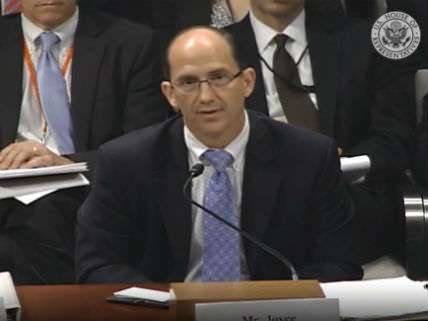The Quarter-Baked Plot to Bomb the New York Stock Exchange

Although the witnesses at yesterday's House Intelligence Committee hearing could not cite a single case where the NSA's phone record database was crucial in preventing a terrorist attack, they did describe a few cases where they said plots were uncovered based on information obtained by monitoring the communications of foreign targets under Section 702 of the Foreign Intelligence Surveillance Act. Nick Gillespie recently explained the grounds for skepticism about two of those cases: Najibullah Zazi's plan to bomb the New York City subway system and David Headley's participation in a conspiracy to bomb the offices of the Danish newspaper Jyllands-Posten. At yesterday's hearing Deputy FBI Director Sean Joyce offered a fresh example, involving an alleged plot to bomb the New York Stock Exchange:
Monitoring a terrorist in Yemen, the N.S.A. discovered that he was talking to a man named Khalid Ouazzani in Kansas City, Mo. After applying for a separate warrant for Mr. Ouazzani's communications, they identified two additional conspirators and discovered they were "in the very initial stages" of the stock exchange bomb plot, he said.
Mr. Ouazzani pleaded guilty in 2010 to sending money to Al Qaeda but was not charged with any domestic plots. Later on Tuesday, law enforcement officials said Mr. Joyce had been referring to Sabirhan Hasanoff and Wesam El-Hanafi, two Brooklyn men who pleaded guilty to providing material support to terrorism.
A sentencing memorandum filed by prosecutors contends that in 2008, "at the direction of a senior terrorist leader," Mr. Hasanoff conducted surveillance of the New York Stock Exchange and sent the leader a one-page report on it.
"The report was rudimentary and of limited use" for any terrorist operation, the memo acknowledges, while nevertheless contending that Mr. Hasanoff's willingness to conduct such surveillance bolstered the case for giving him a 20-year sentence.
At the hearing, [Rep. Mac] Thornberry [R-Texas] asked Mr. Joyce whether the stock exchange attack was a "serious plot" or just "something that they kind of dreamed about." Mr. Joyce replied, "I think the jury considered it serious, since they were all convicted."
Evidently Joyce forgot that the case was a matter of public record:
Joshua L. Dratel, a lawyer for Mr. Hasanoff, called Mr. Joyce's portrayal "astonishing" because none of the defendants was charged with the stock exchange allegation and there was no jury trial in any of the cases.
As is often the case with the foiled terrorist plots highlighted by the government, this one does not even rise to the level of a half-baked scheme, so it is a bit of a stretch to count it as an example of how Section 702 saves Americans' lives.
Addendum: More than a bit of a stretch. Wired reports that "even the government's own sentencing memorandum shows that the defendants called off a proposed plot on their own, without involvement from federal authorities." Here is the relevant passage from the memo:
Hasanoff relayed that the New York Stock Exchange was surrounded by approximately four streets that were blocked off from vehicular traffic and that someone would have to walk to the building. The Doctor [an undisclosed high-ranking al-Qaida operative] revealed that, although the information provided by Hasanoff could be used by someone who wanted to do an operation, he was not satisfied with the report, and he accordingly disposed of it. (The report apparently lacked sufficient detail about New York Stock Exchange security matters to be as helpful as the Doctor had hoped.)